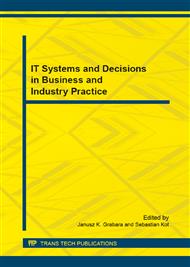[1]
M. Francis, R. Fisher, A. Thomas, H. Rowlands, The meaning value, in purchasing, Logistics and Operations Management, International Journal of Production Research, Volume 52, Issue 22, 2014, pp.6576-6589.
DOI: 10.1080/00207543.2014.903349
Google Scholar
[2]
B. Nogalski , R. Ronkowski , Modern enterprise. Problems of functioning and hiring, Scientific Society for Organization Management. The Association of Higher Utility, Organizer's House, Toruń, (2007).
Google Scholar
[3]
A. Ptak, Decision support systems in manufacturing companies of automotive industry, TTS Technique of the Railway Transport 9 (2012) 2843-2848.
Google Scholar
[4]
C. K Tyran, Designing the spreadsheet –based decision support systems course: An application of Bloom's taxonomy, Journal of Business Research 63, (2010).
DOI: 10.1016/j.jbusres.2009.03.009
Google Scholar
[5]
V. Ciurea, I. Grabara, M. Man, I.C. Dima, Expert systems used in industrial production management, Polish Journal of Management Studies 2 (2010) 57-68.
Google Scholar
[6]
D.J. Wheeler, Understanding Variation: The Key to Managing Chaos, ProdPress. com, Wrocław, 2008. (10).
Google Scholar
[7]
S. Borkowski, Toyotarism. BOST test results, Managerial Publishing House PTM, Warszawa, 2012b.
Google Scholar
[8]
S. Borkowski, Toyota management principles in questions. BOST test results, Managerial Publishing House PTM, Warszawa, 2012c.
Google Scholar
[9]
M. Ingaldi, Determination of the technological position of the courier services company. International Journal Transport & Logistics, Issue 28/2013, Volume 13/(2013).
Google Scholar
[10]
J. Dzieńdziora, Assessment of employees. Theoretical and practical approach, Humanitas, Publishing House, Sosnowiec, (2008).
Google Scholar
[11]
A. Chiarini , E. Vagnoni, World-class manufacturing by Fiat. Comparison with Toyota Production Production System from a Strategic Management, Management Accounting, Operations Management and Performance Measurement dimension International Journal of Production Research, Volume 53, Issue 2, (2015).
DOI: 10.1080/00207543.2014.958596
Google Scholar
[12]
J.K. Likier, The Toyota way - 14 management principles of the world's leading production company, MT Business, Warszawa, (2005).
Google Scholar
[13]
N.P. Fiedorenko, Dictionary of mathematics and cybernetics economy, PWE, Warszawa, (1985).
Google Scholar
[14]
K. Lestyanszka Skurkova, M. Ingaldi, Recycling process of the aluminium cans as an example of the renewable material sources, Advanced Materials Research, Volume 1001 (2014) pp.103-108.
DOI: 10.4028/www.scientific.net/amr.1001.103
Google Scholar
[15]
S. Borkowski, R. Olejnik, A. Noga, Practical use of the topological metric in the BOST method, w: S. Borkowski, R. Olejnik (red. ) Improvement of the BOST method results interpretation, Faculty of Logistics, University of Maribor, Celje, (2014).
Google Scholar
[16]
V. Modrák, I.C. Dima , M. Man, Methodical approach to corporate sustainability planning, Polish Journal of Management Studies 3 (2011) 157-167.
Google Scholar
[17]
W. Griffin Ricky, Fundamentals of organizational management, PWN, Warszawa, (2000).
Google Scholar
[18]
M. Kotus, T. Holota, T. Paulicek, M. Petrik, M. Sklenar, Quality and reliability of manufacturing process in automation of die-casting. Advanced Materials Research, vol. 801, Special Issue, 2013, pp.103-107.
DOI: 10.4028/www.scientific.net/amr.801.103
Google Scholar
[19]
S. Borkowski, Usefulness of BOST method, to access enterprises functioning, Managers Association for Quality and Production Publishing House, Częstochowa, (2013).
Google Scholar
[20]
B. Pułaska –Turyna, Statictics for Economists, Difin, Warszawa, (2014).
Google Scholar
[21]
I.C. Dima, J. Grabara, M. Man, V. Modrak, I. R. Goldbach, Applying of mathematics methods in decision taking process concerning replacement of machines and equipments used in flexible manufacturing cells, Recent Researches in Applied Mathematics (2010).
Google Scholar


